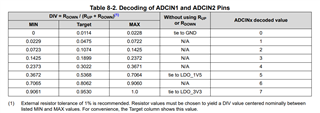Dear TI team
I have a question about "Table 9-5" in the datasheet.
It seems that the mode setting changes depending on the combination of decoded values of ADCIN1 and ADCIN2.
I do not understand the relationship between the meaning of numerical values such as Decode value "7,5,2,1" and the AD input value.
So I checked the thread below.
Although it is not mentioned in the datasheet, I referred to the diagram in the above thread.
Is it correct to understand that the calculated value of "0 to 7" can be obtained by inputting the value of "target" x 3.3V to ADCIN1/ADCIN2?
(The TPS25750 LDO_3.3V pin output can be divided down and connected to ADCINx.)
Also, please tell me about setting the TPS25750D as a "sink".
Should I select "Safe Mode" if I load the patch from EEPROM and do not want to enable power path until negotiation is complete?
Please let me know if I'm missing something.
Best Regards,
Taroimo



